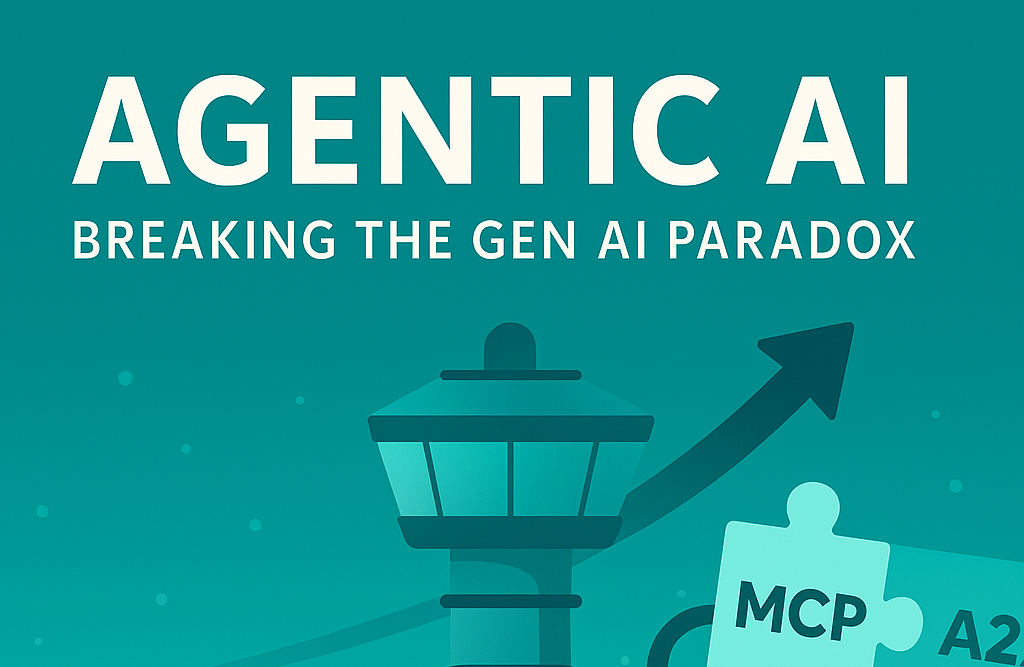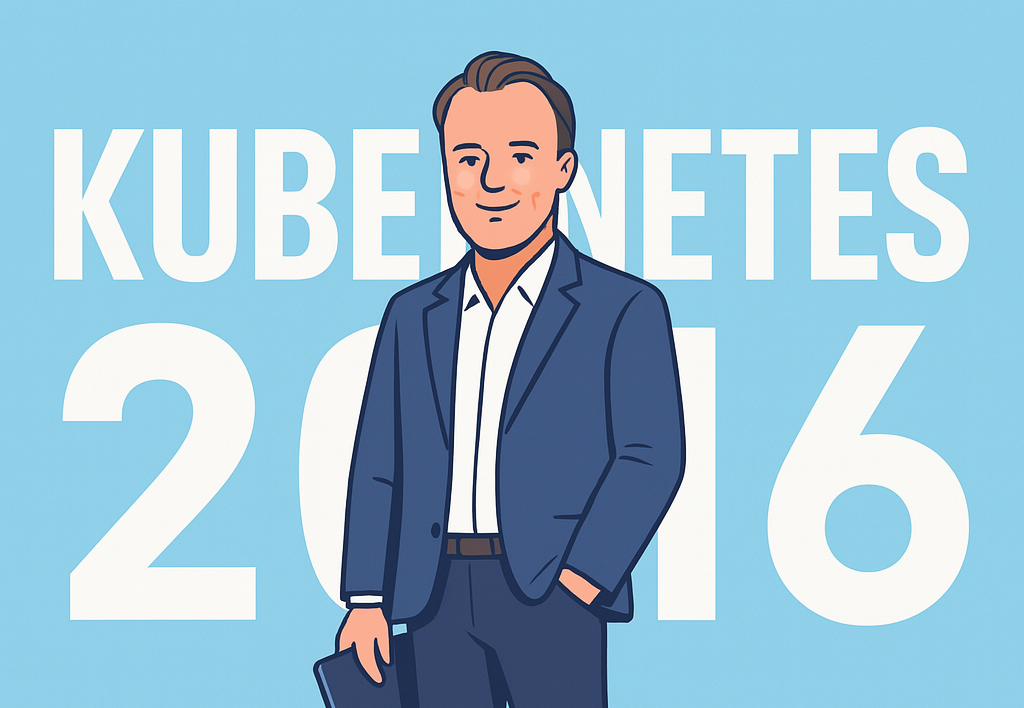Seizing the Agentic AI Advantage with MCP and A2A: The gen AI paradox
Discover how agentic AI breaks through the 'gen AI paradox' and why MCP and A2A protocols are critical for the enterprise transformation. Learn how Palma.ai creates the foundation for autonomous AI agents that drive real business impact.

The Uncomfortable Truth About Enterprise AI
As CEO of Palma.ai, I've had countless conversations with enterprise leaders over the past year. They all start the same way: "We're investing heavily in AI, but where's the real impact?" It's a question that haunts boardrooms across every industry.
The numbers tell an uncomfortable story. Despite nearly 80% of companies reporting generative AI adoption, just as many see no meaningful bottom-line impact. McKinsey calls this the "gen AI paradox"—and it's exactly what we've been witnessing firsthand.
The issue isn't the technology itself. It's how we've been deploying it. Most organizations have focused on horizontal tools—enterprise copilots and chatbots that scale quickly but deliver diffuse, hard-to-measure gains. Meanwhile, the transformative vertical use cases that could revolutionize specific business functions rarely escape the pilot phase.
Only 1% of enterprises view their gen AI strategies as mature. More than 80% still report no material contribution to earnings from their AI initiatives. This isn't a technology problem—it's an architecture problem.
Why I Believe Agentic AI Changes Everything
The solution isn't to do more of the same. It's to fundamentally rethink what AI can do for business. This is why I'm convinced that agentic AI represents the most important shift in enterprise technology since the internet.
Unlike the reactive, prompt-dependent AI tools of the first generation, AI agents are autonomous and goal-driven. They don't wait for instructions—they understand objectives, break them into actionable steps, coordinate with systems and people, and execute with minimal human intervention.
But here's what really excites me: agents can tackle the complex, multi-step workflows that generate real business value. They combine large language models with memory, planning, and orchestration capabilities. This means they can finally automate the processes that matter most to your bottom line.
The Difference That Matters
Traditional Gen AI: Limited Impact
- Reactive and prompt-dependent
- Limited memory across sessions
- Isolated from enterprise systems
- Cannot handle complex workflows
- Requires constant human intervention
Agentic AI: Transformational
- Proactive and goal-driven
- Persistent memory and learning
- Deep enterprise system integration
- Multi-step workflow automation
- Autonomous decision-making
Real Business Impact: The Evidence is Compelling
The companies already deploying agentic AI aren't just seeing incremental improvements—they're achieving breakthrough results. Let me share three examples from recent McKinsey research that illustrate what's possible:
Banking: $600M Problem Solved
The Challenge: A major bank faced modernizing 400 legacy applications—a $600+ million undertaking using traditional methods.
The Agent Solution: AI agent squads now document legacy apps, write new code, review each other's work, and integrate features autonomously.
Result: 50% reduction in time and effort, 30-40% lower development costs.
Research: From Error-Prone to Profitable
The Challenge: A research firm employed 500+ people for data quality, yet 80% of mistakes were still discovered by clients.
The Agent Solution: Multi-agent system identifies anomalies, explains market shifts, analyzes signals, and synthesizes insights autonomously.
Result: 60% productivity gain, $3+ million annual savings.
Banking: Credit Risk Revolution
The Challenge: Relationship managers spent weeks creating credit-risk memos from 10+ data sources.
The Agent Solution: AI agents extract data, draft sections, generate confidence scores, and suggest follow-ups.
Result: 20-60% productivity increase, 30% faster credit turnaround.
The Infrastructure That Makes It Possible
Here's where most organizations hit a wall. Agentic AI requires a fundamentally different infrastructure than traditional AI tools. You need standardized protocols that enable agents to securely access enterprise systems and coordinate with each other.
This is precisely why we built Palma.ai around two critical protocols: Model Context Protocol (MCP) for agent-to-system integration and Agent-to-Agent (A2A) for multi-agent coordination. Without these foundations, agentic AI remains a promising pilot that never scales.
The Two Pillars of Agentic Infrastructure
MCP: Connecting Agents to Your Business
MCP is the "universal translator" that allows AI agents to securely interact with your enterprise systems in real-time. Without it, agents are isolated islands that can't access the data and tools they need to be effective.
- Secure enterprise data access
- Standardized tool integration
- Real-time system interactions
- Role-based access control
A2A: Enabling Agent Collaboration
A2A enables specialized agents to communicate and collaborate on complex workflows. It's the difference between having individual AI tools and having an AI workforce that can tackle enterprise-scale challenges.
- Agent discovery and communication
- Task delegation and coordination
- Workflow orchestration
- Multi-agent collaboration
MCP enables vertical integration with your business systems, while A2A enables horizontal collaboration between agents. Together, they create the complete foundation for enterprise agentic AI.
Building the Agentic AI Mesh: A New Enterprise Architecture
To achieve the kind of results I described earlier, you need more than just protocols—you need a completely new architectural approach. McKinsey calls this the "agentic AI mesh"—a composable, distributed architecture that enables multiple agents to reason, collaborate, and act autonomously across your entire enterprise.
Five Design Principles for Success
Composability
Plug in any agent, tool, or model without system rework
Distributed Intelligence
Tasks decomposed across networks of cooperating agents
Layered Decoupling
Modular logic, memory, orchestration, and interfaces
Vendor Neutrality
Open standards like MCP and A2A over proprietary protocols
Governed Autonomy
Embedded policies and escalation for safe operation
How Palma.ai Delivers This Vision Today
While others are still debating the future of agentic AI, we're building it. Our MCP Enterprise Gateway provides the infrastructure foundation that McKinsey identifies as critical for agentic AI success. We're not preparing for tomorrow—we're enabling transformation today.
Enterprise-Grade Foundation
Our MCP gateway delivers the security, scalability, and governance that enterprise agentic AI demands. Every agent interaction is governed by role-based permissions, logged for compliance, and protected by zero-trust architecture.
✓ Centralized access control
✓ Complete audit trails
✓ Zero-trust security
✓ Real-time monitoring
Multi-Agent Orchestration
Our A2A protocol support enables sophisticated multi-agent workflows. Agents can discover each other's capabilities, intelligently route work, and coordinate complex business processes with full governance oversight.
✓ Dynamic agent discovery
✓ Intelligent work routing
✓ Process coordination
✓ Ecosystem governance
Business Process Transformation
We enable the shift from task automation to complete process reinvention. Agents drive end-to-end workflows spanning multiple systems, with seamless handoffs between AI and human workers.
✓ End-to-end process automation
✓ Human-AI collaboration
✓ Real-time optimization
✓ Performance analytics
Breaking Free from the Gen AI Paradox
The organizations breaking through the gen AI paradox are making four critical shifts in their approach. Based on what we're seeing with our clients and McKinsey's research, here's how Palma.ai enables each transformation:
From Scattered Experiments → Strategic Programs
Stop chasing random use cases. Align AI initiatives directly with strategic business priorities.
How Palma.ai helps: Enterprise-wide MCP deployment that supports coordinated AI programs, not fragmented experiments.
From Use Cases → Business Processes
Move beyond optimizing individual tasks to transforming entire business workflows.
How Palma.ai helps: Process-wide agent deployment through standardized connections across all enterprise systems.
From AI Teams → Cross-Functional Squads
Success requires business experts, AI engineers, and data specialists working together.
How Palma.ai helps: Unified platform that bridges technical and business teams through intuitive governance tools.
From Experiments → Industrial Scale
Design solutions from day one to scale both technically and financially.
How Palma.ai helps: Production-ready infrastructure with built-in monitoring, compliance, and cost optimization.
A CEO's Call to Action
If you're a CEO reading this, let me be direct: the agentic AI transformation cannot be delegated. This isn't another IT initiative or innovation project. This is a fundamental rewiring of how your company operates.
The experimentation phase is over. While your competitors are still running pilots and writing reports, you can be building the agentic AI foundation that will define the next decade of your industry.
As Arthur Mensch, CEO of Mistral AI, puts it: "The technology to build powerful agents is already here. The opportunity now is to deploy agents in ways that are deeply tied to how value is created and how people work."
Three Actions for CEOs This Quarter
1. End the Pilot Purgatory
Conduct a structured review of your AI initiatives. Retire unscalable pilots and refocus on strategic programs targeting your highest-impact business processes.
2. Restructure AI Governance
Form a strategic AI council with your business leaders, CHRO, CDO, and CIO. This isn't about technology governance—it's about business transformation governance.
3. Launch Your Lighthouse Project
Identify one high-impact business process and commit to full agentic transformation. Build the infrastructure foundation while delivering immediate value.
Your Agentic Future Starts Today
The question isn't whether agentic AI will transform your industry—it's whether you'll lead that transformation or be disrupted by it. At Palma.ai, we're building the infrastructure that makes this transformation possible, practical, and profitable.
Ready to Break Through the Paradox?
Phase 1: Foundation (30-60 days)
- Deploy secure MCP gateway
- Connect critical enterprise systems
- Establish governance framework
- Launch first vertical use case
Phase 2: Scale (60-120 days)
- Add A2A protocol support
- Deploy multi-agent workflows
- Expand across business functions
- Measure and optimize impact
The companies that thrive in the next decade won't be those with the best AI tools—they'll be those with the best agentic AI infrastructure. That infrastructure is available today through Palma.ai's MCP Enterprise Gateway.
"Like any truly disruptive technology, AI agents have the power to reshuffle the deck. Done right, they offer laggards a leapfrog opportunity to rewire their competitiveness. Done wrong—or not at all—they risk accelerating the decline of today's market leaders." — McKinsey & Company
The Time for Transformation is Now
Don't let the gen AI paradox define your organization's future. Connect with our team and start building your agentic AI advantage today.
References
McKinsey & Company. "Seizing the agentic AI advantage: A CEO playbook to solve the gen AI paradox and unlock scalable impact with AI agents." June 2025.
McKinsey Global Survey on AI. "The state of AI: How organizations are rewiring to capture value." March 2025.
Foreword by Arthur Mensch, CEO of Mistral AI, in "Seizing the agentic AI advantage," McKinsey & Company, June 2025.
Read More

Why Google's Agent-to-Agent Gift Feels Like Kubernetes All Over Again
Google's donation of the A2A protocol to the Linux Foundation mirrors what happened in 2015 with kubernetes. Patrick Gruhn was part of that wave with his previous company (exit to cisco), Replex.io, and now part of the next wave with palma.ai. This analysis explores how standardized AI protocol, will reshape enterprise AI infrastructure—and why having the right management layer matters now.

The New Protocol Era: How MCP and Agent2Agent Are Following the Kubernetes Playbook
Google's donation of Agent2Agent to the Linux Foundation signals standardized AI agent communication. Discover how MCP and A2A protocols are creating the Kubernetes moment for enterprise AI.
Ready to Future-proof your AI Strategy?
Transform your business with secure, controlled AI integration
Connect your enterprise systems to AI assistants while maintaining complete control over data access and user permissions.